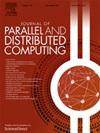Experience with adapting to a software framework for a use-case in computational science
IF 3.4
3区 计算机科学
Q1 COMPUTER SCIENCE, THEORY & METHODS
引用次数: 0
Abstract
The effective use of HPC infrastructure critically depends on the human resources involved in the maintenance and operation of these systems alongside the domain scientists and scientific programmers who develop scientific applications to leverage these systems. The workforce typically consists of undergraduates/postgraduates in different fields with broad areas of training in scientific computing and some programming skills with aptitude in HPC. However, there is a gap in the university-level curriculum and the skill set required to adapt to the requirements for developing scientific applications. Some efforts are there to fill this gap through workforce training programs to prepare the graduates for HPC jobs in industry/national labs. In this work, we share our experience training the workforce to adapt to AMReX (https://amrex-codes.github.io/amrex/docs_html/), a software framework developed under the Exascale computing project for scientific application development. It requires recapitulation of partial differential equations (PDEs), an indispensable mathematical model for describing physical systems across different scientific domains. We discuss our engagement with the intern, the trainees, and the development team in orienting them to scientific computing on the HPC platform, PDE solvers in particular. We highlight some of the features of the AMReX framework that helped the development team to contribute AMReX-based phase field solvers in the MicroSim phase field solver suite as a case study in adapting to the framework. These solvers can target different architectures without modifications due to the abstraction layer that provides immunity to developers for programming on different architectures. This experience can help to evolve a training model to build the HPC workforce.

有适应计算科学用例的软件框架的经验
HPC基础设施的有效使用主要取决于维护和操作这些系统的人力资源,以及开发利用这些系统的科学应用程序的领域科学家和科学程序员。劳动力通常由不同领域的本科生/研究生组成,他们在科学计算方面接受过广泛的培训,并具备一些在高性能计算方面有天赋的编程技能。然而,在大学水平的课程和适应发展科学应用所需的技能方面存在差距。一些努力通过劳动力培训计划来填补这一空白,为毕业生在工业/国家实验室的高性能计算工作做好准备。在这项工作中,我们分享了培训员工适应AMReX (https://amrex-codes.github.io/amrex/docs_html/)的经验,AMReX是在Exascale计算项目下为科学应用程序开发的软件框架。它需要对偏微分方程(PDEs)进行重述,偏微分方程是描述不同科学领域物理系统不可或缺的数学模型。我们与实习生、受训者和开发团队讨论如何引导他们在HPC平台上进行科学计算,特别是PDE求解器。我们重点介绍了AMReX框架的一些特性,这些特性帮助开发团队在MicroSim相场求解器套件中贡献了基于AMReX的相场求解器,作为适应该框架的案例研究。由于抽象层为开发人员在不同的体系结构上编程提供了免疫力,因此这些求解器可以针对不同的体系结构而无需修改。这种经验可以帮助发展培训模式,以建立HPC劳动力。
本文章由计算机程序翻译,如有差异,请以英文原文为准。
求助全文
约1分钟内获得全文
求助全文
来源期刊

Journal of Parallel and Distributed Computing
工程技术-计算机:理论方法
CiteScore
10.30
自引率
2.60%
发文量
172
审稿时长
12 months
期刊介绍:
This international journal is directed to researchers, engineers, educators, managers, programmers, and users of computers who have particular interests in parallel processing and/or distributed computing.
The Journal of Parallel and Distributed Computing publishes original research papers and timely review articles on the theory, design, evaluation, and use of parallel and/or distributed computing systems. The journal also features special issues on these topics; again covering the full range from the design to the use of our targeted systems.
 求助内容:
求助内容: 应助结果提醒方式:
应助结果提醒方式:


